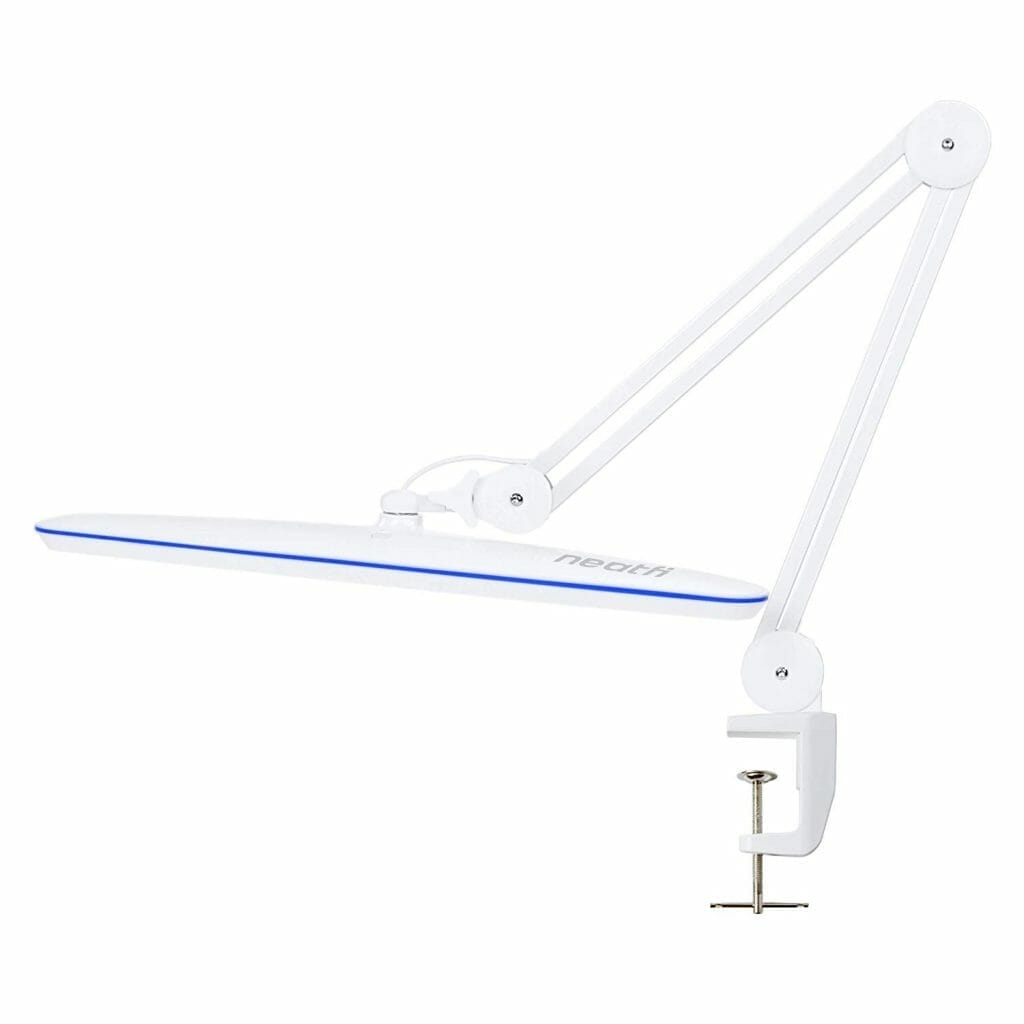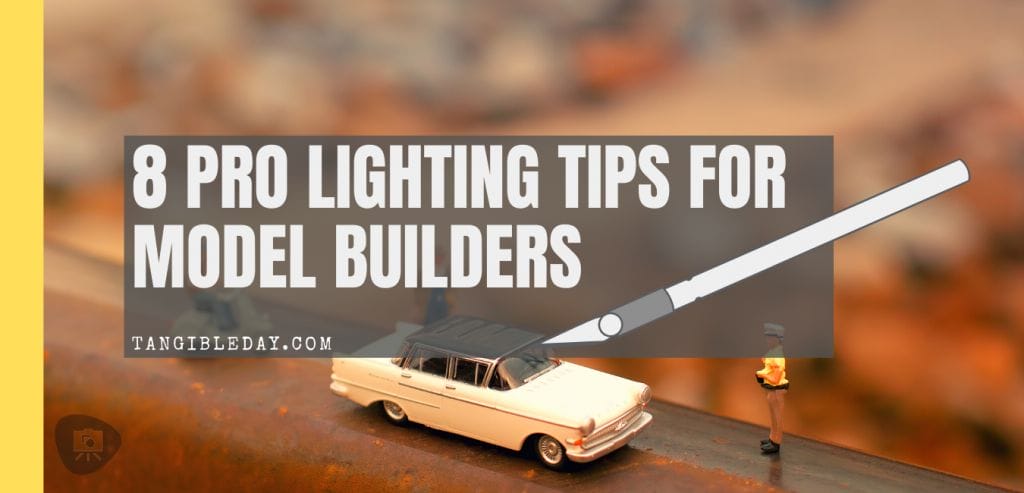Are you looking for the best light for model building? As a scale modeler and painter, I rely on good lighting to see and work with small details. Assembling and painting scale miniatures and models requires visual acuity. Most household desk lamps are too dim, lack contrast, and can even hurt our eyes over when overused. If you’re looking to upgrade your hobby lamps for scale modeling hobbies, e.g., historical pieces, dioramas, gunpla, check out my tips and recommendations.
Here I share 8 lighting tips for scale model building and hobbies.
Key Points
- Natural sunlight is the best kind of light, but when you’re working indoors or in the evening, this might be hard to come by
- The best lights for model building or assembly are bright, diffuse, and carry a neutral color-temperature (e.g., daylight lamps)
- Consider ergonomics, durability, and other features, like touch control dimmers
Continue reading for quick tips when choosing the best lamps for scale modeling!
8 Tips for Choosing the Best Light for Model Making:
1. Choose a lamp with good ergonomics
Ergonomics is the science of understanding and improving an individual’s operating environment. Whether it is the cockpit of a jet fighter, or your hobby desk, applying good ergonomic design to your workspace is essential for any efficient, enjoyable activity.
In general, you want a lamp that can move around your desk or table space. That means you’ll likely want a lamp with an articulating swing arm and swivel head. To underscore this point, I use a Neatfi XL task lamp, which brightly illuminates the majority of the open space on my desk. I’ve written a full review of the Neatfi XL lamp for working with miniatures.

Whether it is a daylight modeling lamp for hobby work, or simply for office tasks, you want your light to go where you need it.

2. Try before you buy
In this digital age, most of what we purchase is from online stores. But, when it comes to something you’ll use often, like a lamp, trying out the product before you buy is a good idea. Of course, this means going into your local Office Depot, hardware store, or even the fancier art stores, to try out their lighting equipment.
READ MORE: BEST LAMP AND LIGHT FOR PAINTING MINIATURES
If you’re adamant on purchasing online, then make sure you’ve got the option to return your lamp.
3. Consider magnifying lights or lamps for close up detail work
If you’re modeling scale trains, for example, you’ll have a lot of small parts to keep track of. As you age, your ability to discern fine detail will deteriorate (though you’ll gain wisdom and hopefully more free time!).

At one point in my early hobby “career”, I shunned the hobby magnifier lamps. Whether it was pride or simple stubbornness, I was a fickle spender and wanted to spend my budget on “useful things”. But, I learned the hard way that sometimes, you need special help.
RELATED: BEST MAGNIFYING DESK LAMPS FOR MODELING HOBBIES

A magnifier lamp may not always be necessary, but the obvious benefit of these kinds of lights is that they provide illumination AND magnifying power.
4. Avoid lamps that flicker
Avoiding fluorescent lamps that flicker is a safety issue. Some lamps flicker. That is, the light actually winks. The light will switch between very bright and dark quickly. It’ll do this so fast you barely register it. But, your eyeballs will slowly fatigue trying to adjust to the changing brightness when a light flickers.
Here’s how light flicker happens with fluorescent lamps and bulbs. With fluorescent lights, electricity is sent to the lamp at a certain frequency or pulse intensity to control brightness. You either send a lot of electricity into a bulb to make it bright, or you pulse the electricity to control how bright a bulb shines.
If the pulsing electricity isn’t delivered properly, or the lamp doesn’t respond optimally, you’ll notice the light flickering. Over time, the muscles that control how wide your iris’ are can tire out. Your eye muscles will fatigue because they are constantly adjusting to the lighting changes. This can lead to headaches, sleepiness, and other discomfort.

For the most part, you can avoid light flicker by purchasing a high-quality lighting system, or avoiding older technologies like fluorescent bulbs (which use electrical pulsing for controlling brightness).
Note: It is possible to evoke epileptic seizures in some people who are sensitive to light flicker (source). So, there is a safety reason for choosing good light.
5. Color temperature is important for hobby work
If you’re assembling small parts, then using a lamp that reproduces accurate color and contrast on your working surface will help.
There are two ways to ensure good color temperature on your hobby working surfaces, e.g., your models, parts, or tools:
- Choose a daylight lamp (or also known as a full spectrum light)
- If you plan to use multiple lamps, then try and use the same kind of lamps for all of them
A lot of hobbyists already know that a daylight full spectrum lamp is the best for accurate color representation on the workspace. For example, here’s an affordable daylight lamp. On the other hand, few people realize that having multiple lights shining on the same area, but of different types of light (and thus, color temperature) creates a fairly muddy picture of your space.
The different color temperature light from multiple light sources can distort how parts looks and change how micro-shadows are cast against other objects.
Ask a really good professional wedding photography how difficult it is to shoot proper images in an indoor environment with lit candles, overhead fluorescent lights, and large windows to a bright afternoon sun. Sure, you may not need this level of accuracy, but it all counts.
6. Avoid incandescent bulbs
For the most part, this tip is related to choosing lamps with good color temperature (e.g., full spectrum lights).
MORE: RECOMMENDED DAYLIGHT BULBS FOR ARTISTS
Incandescent bulbs are great for reading, bad for hobby work. They cast a very yellow, warm kind of light that tends to reduce contrast. Reduced contrast makes details harder to see.
7. Soft light is better than hard light
A great lamp for modeling hobbies is one that is bright and produces soft, diffuse illumination. You need both bright and diffuse light. Harsh illumination that produces hard reflections, e.g., spots that are super bright, is just as bad as lighting that is too dark. Contrast is most useful for model building because it helps maintain your ability visually resolve detail.

Sure, color matters, because it helps your eyes accurately discern different small elements you’re working on (e.g., that green plastic is different than that brown colored putty). Contrast is what makes it possible to see depth, or the ability to resolve a fine detail element. A surface farther away must feel like it is some distance away from you.
Bright surfaces must look different than shadows or dark surfaces. Contrast provides you with additional cues to help you with depth-perception. Along with stereoscopic principles associated with having two eyes, offset by some distance across your face, contrast is vital. So, in choosing the best lamp for assembling models, aim for lamp that provides excellent contrast.
8. Bad lighting can damage your eyes
Choose a lamp that won’t strain your eyes. It might be a myth that sitting too close to the television can ruin your vision, but it’s not far-fetched that using bad lighting can be harmful.
Here are some symptoms of using bad light for hobby work:
- Headaches
- Squinting
- Seeing spots
Taking together, you can avoid these symptoms of bad lighting by reducing the presence of light flicker, and use lamps that focus too much light in a small area.
What light should I get for model building?
Here are 2 recommended lights for working with fine scale models. Both of these lamps produce bright light with sufficient softness to help you see details and produce neutral daylight temperature lights over your working hobby surface.
The Neatfi XL (reviewed in-depth here) is the perfect hobby lamp for almost all modeling work. Whereas the Lightview Pro has a built-in magnifying glass to help you see finer details on your models.
Final Word
Here are the 8 simple tips for choosing a lamp for modeling hobbies:
- Choose a lamp with good ergonomics
- Try before you buy
- Consider magnifier lamps for detailed hobby work
- Avoid lamps that flicker
- Color temperature is important for hobby work
- Avoid incandescent bulbs
- Soft light is better than hard light
- Bad lighting can damage your eyes

The neat part about whatever you choose is that a lamp that is good for building models also serves well for arts & crafts and do-it-yourself (DIY) maker spaces.
Thank you for reading. I hope you found this article useful. If you have other tips or suggestions for lighting and modeling hobbies, please let me know with a comment below!
Happy scale modeling!

Tangible Day on YouTube (Miniatures and More!)




All great advice. Spending money on a good light was one of the best things I ever did as a hobbyist. It’s so worth it.
Thank you. I’m shopping for another lamp actually, and I am totally getting the best one I can find. Need to upgrade my lamps to all LEDs; they are so worth the cost.
Pingback: 8 Professional Lighting Tips for Model Builders — Tangible Day | Ups and Downs of Family History V2.0